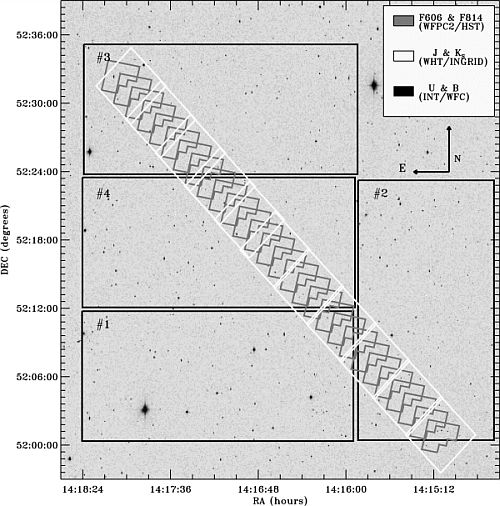INT+WFC, WHT+INGRID
The Galaxy Origins and Young Assembly (GOYA) survey is designed to study the formation and evolution of galaxies with the aim of learning on the epoch and the mechanisms by which galaxies assembled the bulk of their stars and acquired their present structure and dynamics.
For this, a near-infrared/optical observational program using some of the most powerful ground-based telescopes and public data is being conducted to map 0.5 square degrees of high-latitude sky. As the main scientific force behind the design of EMIR
(a NIR cryogenic multi-slit spectrograph for the 10.4m GTC at Roque de Los Muchachos Observatory), GOYA emphasizes the use of near-infrared observations, which sample the optical rest-frame spectrum of galaxies at very high redshifts.
The GOYA photometric survey is a multicolor survey in six broadband filters (U, B, V, I, J, Ks) with target depths of U=B=V=I=26 and J=K=22 (AB magnitudes). Its principal aim is to generate a galaxy database for sample selection and characterization for subsequent NIR spectroscopy with
EMIR. The U and B imaging presented came from observations carried out with the INT WFC and covers the Groth-Westphal Strip (GWS). The GOYA Survey has also reduced and analyzed data over this field in NIR filters from WHT INGRID (J and Ks)
and in visible filters from HST WFPC2 (F606W and F814W). Originally, the GWS field was defined as 28 HST WFPC2 pointings extended along a 45' strip. It has an area of ~150 arcmin2 of sky. Compared to other existing optical–NIR surveys,
GOYA offers a notable increase in the depth times area product in several filters, compiling complementary photometry in six optical–NIR bands and morphological and surface brightness information from high-resolution HST WFPC2 images.
 |
Observations of the GOYA Survey at the GWS region over a DSS image. The 28 HST WFPC2 pointings defining the GWS in F606W and F814W are shown in gray, while J and Ks WHT INGRID fields are shown in white.
The GWS runs diagonally across the wide 45'×45' field marked in black, which corresponds to the INT WFC field (U and B data). Numbers in black indicate positions and orientations of the four chips of WFC.(Extracted from Eliche-Moral et al., 2006,
ApJ, 639, 644). [ JPEG ]
|
Counts were derived over 18.0<U<25.0 and 19.5<B<25.5. These wide ranges (7 mag in U and 6 mag in B) result from the combination of wide area and depth of the survey. In both bands, the number counts are in
good agreement with other studies that cover fainter and brighter magnitudes. When combined with Ks number counts, the data provide strong constraints on galaxy formation models, due to the presence of a knee at Ks=17.5 in the NIR counts and the
absence of such a feature in blue passbands. Adopting a Λ-dominated cosmological model, a simple number count model including luminosity evolution and a galaxy number evolution accurately reproduces the observed counts in U, B and Ks in a consistent way.
Extensive modeling suggests that only by assuming a moderately low formation redshift for the dominant NIR population (elliptical galaxies) does the model reproduce the Ks=17.5 knee, while reproducing the lack of a knee in U and B
counts in turn requires the adoption of a moderate optical depth for all galaxy types, including elliptical galaxies. Neither of the two assumptions is at odds with current ideas on galaxy formation and evolution in hierarchical universes.
References:
- M. Carmen Eliche-Moral et al., 2006, "GOYA Survey: U and B Number Counts in the Groth-Westphal Strip", ApJ, 639, 644.
- D. Cristóbal-Hornillos et al., 2003, "Ks Number Counts in the Groth and Coppi Fields", ApJ, 595, 71.
- M. Balcells et al., 2002, "The COSMOS Survey", ING Newsl., 6, 11.
- IAC Annual Report 2006.
|



